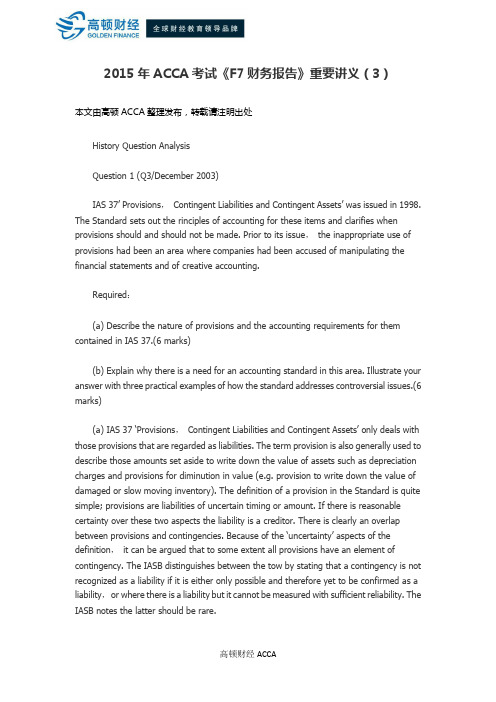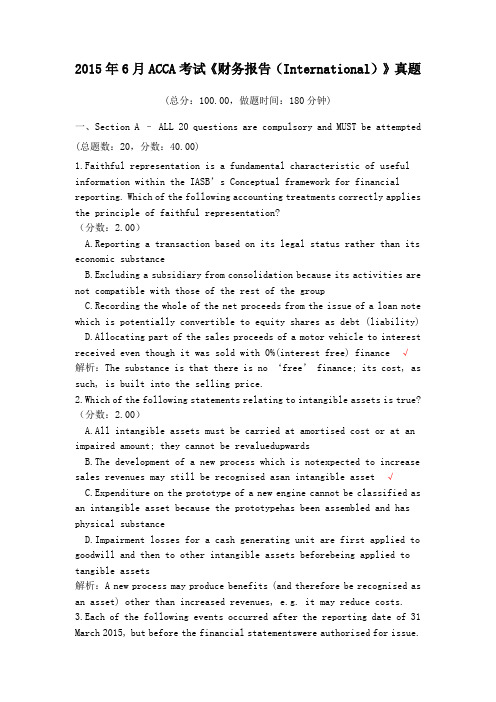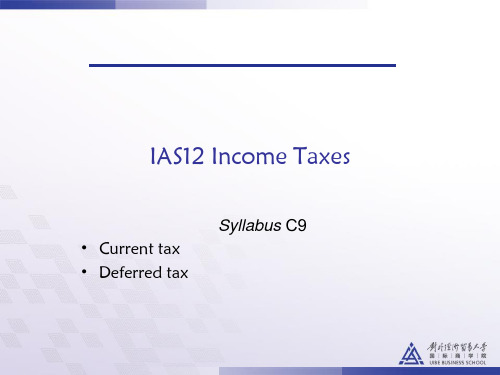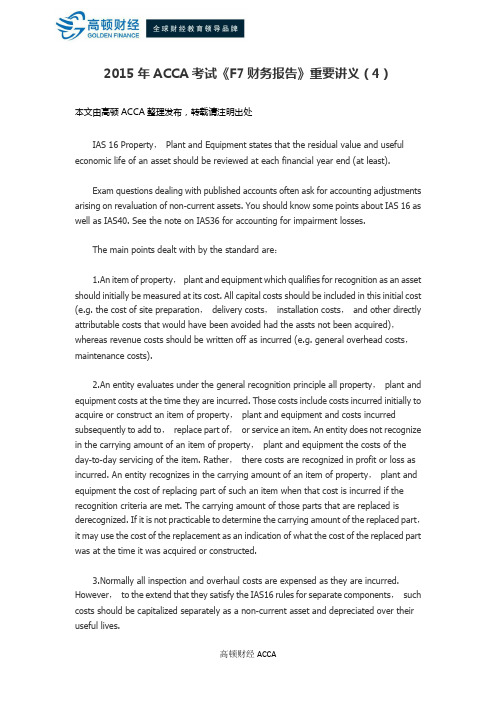2015年ACCA考试《F7财务报告》重要讲义(1)
- 格式:doc
- 大小:62.96 KB
- 文档页数:4

2015年ACCA考试《F7财务报告》重要讲义(3)本文由高顿ACCA整理发布,转载请注明出处History Question AnalysisQuestion 1 (Q3/December 2003)IAS 37’ Provisions,Contingent Liabilities and Contingent Assets’ was issued in 1998. The Standard sets out the rinciples of accounting for these items and clarifies when provisions should and should not be made. Prior to its issue,the inappropriate use of provisions had been an area where companies had been accused of manipulating the financial statements and of creative accounting.Required:(a) Describe the nature of provisions and the accounting requirements for them contained in IAS 37.(6 marks)(b) Explain why there is a need for an accounting standard in this area. Illustrate your answer with three practical examples of how the standard addresses controversial issues.(6 marks)(a) IAS 37 ‘Provisions,Contingent Liabilities and Contingent Assets’ only deals with those provisions that are regarded as liabilities. The term provision is also generally used to describe those amounts set aside to write down the value of assets such as depreciation charges and provisions for diminution in value (e.g. provision to write down the value of damaged or slow moving inventory). The definition of a provision in the Standard is quite simple; provisions are liabilities of uncertain timing or amount. If there is reasonable certainty over these two aspects the liability is a creditor. There is clearly an overlap between provisions and contingencies. Because of the ‘uncertainty’ aspects of the definition,it can be argued that to some extent all provisions have an element of contingency. The IASB distinguishes between the tow by stating that a contingency is not recognized as a liability if it is either only possible and therefore yet to be confirmed as a liability,or where there is a liability but it cannot be measured with sufficient reliability. The IASB notes the latter should be rare.The IASB intends that only those liabilities that meet the characteristics of a liability in its Framework for the Preparation and Presentation of Financial Statements should be reported in the balance sheet.IAS 37 summarises the above by requiring provisions to satisfy all of the following three recognition criteria:- there is a present obligation (legal or constructive) as a result of a past event;- it is probable that a transfer of economic benefits will be required to settle the obligation;A provision is triggered by an obligating event. This must have already occurred,future events cannot create current liabilities. The first of the criteria refers to legal or constructive obligations. A legal obligation is straightforward and uncontroversial,but constructive obligations are a relatively new concept. These arise where a company creates an expectation that it will meet certain obligations that is not legally bound to meet. These may arise due to a published statement or even by a pattern of past practice. In reality constrictive obligations are usually accepted because the alternative action is unattractive or may damage the reputation of the company. The most commonly quoted example of such is a commitment to pay for environmental damage caused by the company,even where there is no legal obligation to do so.To summarise:a company must provide for a liability where the three defining criteria of a provision are met,but conversely a company cannot provide for a liability where they are not met. The latter part of the above may seem obvious,but it is an area where there has been some past abuse of provisioning as is referred to in (b).(b) the main need for an accounting standard in this area is to clarify and regulate when provisions should and should not be made. Many controversial areas including the possible abuse of provision are based on contravening aspects of the above definitions. One of the most controversial examples of provisioning is in relation to future restructuring or recognization costs (often as part of an acquisition). This is sometimes extended to providing for future operating losses. The attraction of providing for this type of expense/loss is that once the provision has been made,the future costs are then charged to the provision such that they bypass the income statement (of the period when they occur). Such provisions can be glossed over by management as ‘exceptional items’,which analysts are expected to disregard when assessing the company’s future prospects. If thistype of provision were to be incorporated as a liability as part of a subsidiary’s n et assets at the date of costs and operating losses (unless they are for an onerous contract) do not constitute past events.Another important change initiated by IAS 37 is the way in which environmental provisions must be treated. Practice in this area has differed considerably. Some companies did provide for such costs and those that did often accrued for them on an annual basis. If say a company expected environmental site restoration cost of $10 million in 10 years time,it might argue that this is not a liability until the restoration is needed or it may accrue $1 million per annum for 10 years (ignoring discounting). Somewhat controversially this practice is no longer possible. IAS 37 requires that if the environmental costs are a liability (legal or constructive),then the whole of the costs must be provided for immediately. That has led to large liabilities appearing in some companies’ balance sheets.A third example of bad practice is the use of‘big bath’ provisions and over provisioning. In its simplest form this occurs where a company makes a large provision,often for non-specific future expenses,or as part of an overall restructuring package. If the provision is deliberately overprovided,then its later release will improve future profits. Alternatively the company could charge to the provision a different cost than the one is was originally created for IAS 37 addresses this practice in two ways:by not allowing provisions to be created if they do not meet the definition of an obligation; and specifically preventing a provision made for one expense to be used for a different expense. Under IAS 37 the original provision would have to be reversed and a new one would be created with appropriate disclosures. Whilst this treatment does not affect overall profits,it does enhance transparency.Note:other examples would be acceptable.(c) Bodyline sells sports goods and clothing through a chain of retail outlets. It offers customers a full refund facility for any goods returned with in 28days of their purchase provided they are unused and in their original packaging. In addition,all goods carry a warranty against manufacturing defects for 12 months from their date of purchase. For most goods the manufacturer underwrites this warranty such that Bodyline is credited with the cost of the goods that are retumed as faulty. Goods purchased from one manufacturer,Header,are sold to Bodyline at a negotiated discount which is designed to compensate Bodyline for manufacturing defects. No refunds are given by Header,thus Bodyline has to bear the cost of any manufacturing faults of these goods.Bodyline makes a uniform mark up on cost of 25% on all goods it sells,except for those supplied from Header on which it makes a mark up on cost of 40%. Sales of goods manufactured by Header consistently account for 20% of all Bodyline’s sales.Sales in the last 28 days of the trading year to 30September 2003 were $1,750,000. Past trends reliably indicate that 10% of all goods are returned under the 28-day return facility. These are not faulty goods. Of these 70% are later resold at the normal selling price and the remaining 30% are sold as ‘sale’ items at half the normal retail price.In addition to the above expected returns,an estimated $160,000 (at selling price) of the goods sold during the year will have manufacturing defects and have yet to be returned by customers. Goods returned as faulty have no resale value更多ACCA资讯请关注高顿ACCA官网:。

2015年6月ACCA考试《财务报告(International)》真题(总分:100.00,做题时间:180分钟)一、Section A – ALL 20 questions are compulsory and MUST be attempted (总题数:20,分数:40.00)1.Faithful representation is a fundamental characteristic of useful information within the IASB’s Conceptual framework for financial reporting. Which of the following accounting treatments correctly applies the principle of faithful representation?(分数:2.00)A.Reporting a transaction based on its legal status rather than its economic substanceB.Excluding a subsidiary from consolidation because its activities are not compatible with those of the rest of the groupC.Recording the whole of the net proceeds from the issue of a loan note which is potentially convertible to equity shares as debt (liability)D.Allocating part of the sales proceeds of a motor vehicle to interest received even though it was sold with 0%(interest free) finance √解析:The substance is that there is no ‘free’ finance; its cost, as such, is built into the selling price.2.Which of the following statements relating to intangible assets is true? (分数:2.00)A.All intangible assets must be carried at amortised cost or at an impaired amount; they cannot be revaluedupwardsB.The development of a new process which is notexpected to increase sales revenues may still be recognised asan intangible asset √C.Expenditure on the prototype of a new engine cannot be classified as an intangible asset because the prototypehas been assembled and has physical substanceD.Impairment losses for a cash generating unit are first applied to goodwill and then to other intangible assets beforebeing applied to tangible assets解析:A new process may produce benefits (and therefore be recognised as an asset) other than increased revenues, e.g. it may reduce costs. 3.Each of the following events occurred after the reporting date of 31 March 2015, but before the financial statementswere authorised for issue.Which would be treated as a NON-adjusting event under IAS 10 Events After the Reporting Period?(分数:2.00)A.A public announcement in April 2015 of a formal plan to discontinue an operation which had been approved bythe board in February 2015 √B.The settlement of an insurance claim for a loss sustained in December 2014C.Evidence that $20,000 of goods which were listed as part of the inventory in the statement of financial positionas at 31 March 2015 had been stolenD.A sale of goods in April 2015 which had been held in inventory at 31 March 2015. The sale was made at aprice below its carrying amount at 31 March 2015解析:A board decision to discontinue an operation does not create a liability. A provision can only be made on the announcement of a formal plan (as it then raises a valid expectation that the discontinuance will be carried out). As this announcement occurs during the year ended 31 March 2016, this a non-adjusting event for the year ended 31 March 2015. 4.Metric owns an item of plant which has a carrying amount of $248,000 as at 1 April 2014. It is being depreciatedat 12?% per annum on a reducing balance basis. The plant is used to manufacture a specific product which has been suffering a slow decline in sales. Metric hasestimated that the plant will be retired from use on 31 March 2017. The estimated net cash flows from the use ofthe plant and their present values are: On 1 April 2015, Metric had an alternative offer from a rival to purchase the plant for $200,000. At what value should the plant appear in Metric’s statement of financial position as at 31 March 2015?(分数:2.00)A.$248,000B.$217,000C.$214,600 √D.$200,000解析:Is the lower of its carrying amount ($217,000) and recoverable amount ($214,600) at 31 March 2015. Recoverable amount is the higher of value in use ($214,600) and fair value less (any) costs of disposal ($200,000)). Carrying amount = $217,000 (248,000 – (248,000 x 12·5%)) Value in use is based on present values = $214,6005.Pact acquired 80% of the equity shares of Sact on 1 July 2014, paying $3·00 for each share acquired. Thisrepresented a premium of 20% over the market price of Sact’s shares at that date.Sact’s shareholders’funds (equity) as at 31 March 2015 were: The only fair value adjustment required to Sact’s net assets on consolidation was a $20,000 increase in the value of its land. Pact’s policy is to value non-controlling interests at fair value at the date of acquisition. For this purpose the marketprice of Sact’s shares at that date can be deemed to be representative of the fair value of the shares held by the non-controlling interest. What would be the carrying amount of the non-controlling interest of Sact in the consolidated statement offinancial position of Pact as at 31 March 2015? (分数:2.00)A.$54,000B.$50,000C.$56,000 √D.$58,000解析:Market price of Sact’s shares at acquisition was $2·50 (3·00 –(3·00 x 20/120)), therefore NCI at acq was $50,000 (100,000x 20% x $2·50). NCI share of the post-acq profit is $6,000 (40,000 x 9/12 x 20%). Therefore non-controlling interest as at 31 March 2015 is $56,000.6.The IASB’s Conceptual framework for financial reporting defines recognition as the process of incorporating in the financial statements an item which meets the definition of an element and satisfies certain criteria. Which of the following elements should be recognised in the financial statements of an entity in the mannerdescribed?(分数:2.00)A.As a non-current liability: a provision for possible hurricane damage to property for a company located in an area which experiences a high incidence of hurricanesB.In equity: irredeemable preference shares √C.As a trade receivable: an amount of $10,000 due from a customer which has been sold (factored) to a financecompany with no recourse to the sellerD.In revenue: the whole of the proceeds from the sale of an item of manufactured plant which has to be maintainedby the seller for three years as part of the sale agreement。


acca9月F7考试题及答案ACCA 9月 F7考试题及答案1. 题目一:财务报表分析问题:请解释财务报表分析的目的,并给出两个常用的财务比率。
答案:财务报表分析的目的是评估企业的财务状况、业绩和盈利能力,以便做出明智的投资和信贷决策。
两个常用的财务比率包括:- 流动比率:衡量企业短期偿债能力,计算公式为流动资产除以流动负债。
- 资产负债率:衡量企业财务杠杆水平,计算公式为总负债除以总资产。
2. 题目二:资本成本问题:说明如何计算加权平均资本成本(WACC)。
答案:加权平均资本成本(WACC)的计算公式为:\[WACC = \frac{E}{V} \times Re + \frac{D}{V} \times Rd\times (1 - Tc)\]其中:- \( E \) 代表企业市场价值的股权- \( V \) 代表企业资本的市场价值总和(\( E + D \))- \( Re \) 代表股权要求的回报率- \( D \) 代表企业市场价值的债务- \( Rd \) 代表债务的税后成本- \( Tc \) 代表公司税率3. 题目三:财务风险管理问题:描述两种财务风险管理策略。
答案:财务风险管理策略包括:- 对冲:通过使用衍生金融工具(如期货、期权)来减少价格波动对企业财务状况的影响。
- 多元化:通过投资不同行业和地区的资产来分散风险,减少单一资产或市场对企业整体财务状况的负面影响。
4. 题目四:现金流量表问题:解释现金流量表中的经营活动、投资活动和融资活动。
答案:现金流量表分为三个部分:- 经营活动:涉及企业日常运营产生的现金流入和流出,如销售收入和运营支出。
- 投资活动:涉及企业购买或出售资产、投资等产生的现金流,如购买固定资产或出售投资。
- 融资活动:涉及企业筹资活动产生的现金流,如发行债券、支付股息或偿还债务。
5. 题目五:财务规划和预算问题:描述财务规划和预算过程的步骤。
答案:财务规划和预算过程包括以下步骤:- 目标设定:确定企业的财务目标和战略。


2015年ACCA考试《F7财务报告》重要讲义(4)本文由高顿ACCA整理发布,转载请注明出处IAS 16 Property,Plant and Equipment states that the residual value and useful economic life of an asset should be reviewed at each financial year end (at least).Exam questions dealing with published accounts often ask for accounting adjustments arising on revaluation of non-current assets. You should know some points about IAS 16 as well as IAS40. See the note on IAS36 for accounting for impairment losses.The main points dealt with by the standard are:1.An item of property,plant and equipment which qualifies for recognition as an asset should initially be measured at its cost. All capital costs should be included in this initial cost (e.g. the cost of site preparation,delivery costs,installation costs,and other directly attributable costs that would have been avoided had the assts not been acquired),whereas revenue costs should be written off as incurred (e.g. general overhead costs,maintenance costs).2.An entity evaluates under the general recognition principle all property,plant and equipment costs at the time they are incurred. Those costs include costs incurred initially to acquire or construct an item of property,plant and equipment and costs incurred subsequently to add to,replace part of,or service an item. An entity does not recognize in the carrying amount of an item of property,plant and equipment the costs of the day-to-day servicing of the item. Rather,there costs are recognized in profit or loss as incurred. An entity recognizes in the carrying amount of an item of property,plant and equipment the cost of replacing part of such an item when that cost is incurred if the recognition criteria are met. The carrying amount of those parts that are replaced is derecognized. If it is not practicable to determine the carrying amount of the replaced part,it may use the cost of the replacement as an indication of what the cost of the replaced part was at the time it was acquired or constructed.3.Normally all inspection and overhaul costs are expensed as they are incurred. However,to the extend that they satisfy the IAS16 rules for separate components,such costs should be capitalized separately as a non-current asset and depreciated over their useful lives.4.The residual value and useful economic life of an asset should be reviewed at least at each financial year-end and revised when necessary. When a material change becomes necessary,the depreciation charge for the current and future periods should be adjusted. The change in depreciation method does not constitute a change of accounting policy.5.Depreciation of an asset begins when it is available for use and ceases at the earlier of the date that the asset is classified as held for sale (IFRS5) and the date that the asset is derecognized.6.The carrying amount of an item of property,plant and equipment shall be derecognized on disposal or when no future economic benefits are expected from its use or disposal.7.Subsequent to initial recognition,the cost model is that property,plant and equipment should be carried at cost less accumulated depreciation subject to any necessary write-down in value.8.The revaluation model is that property,plant and equipment whose fair value can be measured reliably should be carried at a revalued amount being its fair value at the date of revaluation less any accumulated depreciation after revaluation and any necessary write-down in value. On revaluation,the increase in carrying amount must be credited to revaluation surplus,however,if such increase reverses a previous revaluation decrease of the same asset which was recognized as an expense in I/S then the increase is firstly credited to I/S; the revaluation decrease should be recognized immediately as an expense in I/S,however,if there is revaluation surplus on the same asset then such decrease should write off the revaluation surplus firstly.9. Where the revaluation model is adopted,revaluation should be made regularly so that the carrying value of a revalued asset does not differ materially from its fair value at the balance sheet date.更多ACCA资讯请关注高顿ACCA官网:。
ACCA考试F7财务报告History Question Analysis(Question 5 December 2006)(i)State the definition of both non-current assets held for sale and discontinued operations and explain the usefulness of information for discontinued operations. (4 marks)Partway is in the process of preparing its financial statements for the year ended 31 October 2006. The company’s main activity is in the travel industry mainly selling package holidays (flights and accommodation)to the general public through the Internet and retail travel agencies. During the current year the number of holidays sold by travel agencies declined dramatically and the directors decided at a board meeting on 15 October 2006 to cease marketing holidays through its chain of travel agents and sell off the related high-street premises. Immediately after the meeting the travel agencies’ staff and suppliers were notified of the situation and an announcement was made in the press. The directors wish to show the travel agencies’ results as a discontinued operation in the financial statements to 31 October 2006. Due to the declining business of the travel agents,on 1 August 2006 (three months before the year end)Partway expanded its Internet operations to offer car hire facilities to purchasers of its Internet holidays.The following are Partway’s summarised income statement results – years ended:31 October 200631 October 2005Internet travel agencies car hire total total$‘000$’000$‘000$’000$‘000Revenue23,00014,0002,00039,000 40,000Cost ofsales(18,000)(16,500)(1,500)(36,000)(32,000)——————————Grossprofit/(loss)5,000(2,500)5003,0008,000Operatingexpenses(1,000)(1,500)(100)(2,600)(2,000)——————————Profit/(loss)beforetax4,000(4,000)4004006,000——————————The results for the travel agencies for the year ended 31 October 2005 were:revenue $18 million,cost of sales $15 million and operating expenses of $1·5 million.Required:ACCA考试F7财务报告(ii)Discuss whe ther the directors’ wish to show the travel agencies’ results as a discontinued operation is justifiable. (4 marks)(iii)Assuming the closure of the travel agencies is a discontinued operation,prepare the (summarised)income statement of Partway for the year ended 31 October 2006 together with its comparatives. Note:Partway discloses the analysis of its discontinued operations on the face of its income statement.(6 marks)Solution:(a)(i)IFRS 5 Non-current assets held for sale and discontinued operations defines non-current assets held for sale as those assets (or a group of assets)whose carrying amounts will be recovered principally through a sale transaction rather than through continuing use. A discontinued operation is a component of an entity that has either been disposed of,or is classified as ‘held for sale’ and:(i)represents a separate major line of business or geographical area of operations(ii)is part of a single co-ordinated plan to dispose of such,or(iii)is a subsidiary acquired exclusively for sale.IFRS 5 says that a ‘component of an entity’ must have operations and cash flows that can be clearly distinguished from the rest of the entity and will in all probability have been a cash-generating unit (or group of such units)whilst held for use. This definition also means that a discontinued operation will also fall to be treated as a ‘disposal group’ as defined in IFRS 5. A disposal group is a group of assets (possibly with associated liabilities)that it is intended will be disposed of in a single transaction by sale or otherwise (closure or abandonment)。
ACCA F7 财务报告ACCA F7 财务报告学科是财务会计和报告的进阶课程,为会计专业的学生提供了更深入的知识和技能。
这门课程涵盖了企业财务报告的方方面面,包括会计标准、财务报告和财务报告分析等。
在这里,我们将探讨一些与财务报告相关的重要知识点和技能,以帮助您成功地学习这门课程。
一、会计标准会计标准是财务报告编制的基础,因此了解和应用会计标准是非常重要的。
会计标准通常由会计准则委员会(ASB)或国际会计准则委员会(IASB)制定,并包括对财务报告项目的计量、披露和分类等方面的规定。
ACCA F7课程通常涵盖以下会计标准:1、国际财务报告准则(IFRS)2、英国财务报告标准(FRS)3、英国财政部的财务报告标准(SFA)4、会计准则委员会的声明(SME)通过学习会计标准,学生将能够理解在财务报告编制过程中的各个步骤,以及各种会计政策和实践的影响。
二、财务报告财务报告是一项旨在向投资者、债权人和其他各方披露企业财务状况、表现和现金流量的事业。
ACCA F7课程中,学生将学习财务报告的各个方面,包括以下内容:1、利润表利润表显示一个企业的销售收入、成本和利润等财务信息。
在ACCA F7课程中,学生将学习如何正确解读利润表信息,并将其与其他财务报告项目进行比较。
2、资产负债表资产负债表显示一个企业的财务状况,包括其资产、负债和所有者权益等方面的信息。
在ACCA F7课程中,学生将学习如何正确分类和计量一项企业的各种资产和负债,以及如何计算所有者权益的价值。
3、现金流量表现金流量表显示一个企业一段时间内现金流入和流出的情况。
在ACCA F7课程中,学生将学习如何正确编制现金流量表,并解释现金流量项的含义。
三、财务报告分析财务报告分析是一项旨在帮助投资者、债权人和其他各方更好地了解企业财务状况和表现的事业。
ACCA F7课程中,学生将学习如何进行财务报告分析,包括以下方面:1、横向分析横向分析旨在比较一个企业的财务报告项目在不同时期的变化情况。
ACCA考前复习指南:F7重要知识点.考点总结改革之后的F7考试,考查范围更加全面。
同学们在备考的时候,需要对每个准则基本内容进行准备。
考官一般围绕recognition , measurement和presentation等方面考查。
而选择题部分,考前可以结合三套真题的选择题和练习册的选择题梳理知识点。
试卷分析SectionA备考要点■仔细读题■理解准则基础■排除法,举反例■计算题排除干扰自己算SectionB备考要点■计算ratio ,分类别(profitability/liquidity/gearing/i n vest or)■关注题目角色,以谁的角度写report■又寸比ratio :纟吉合题目要求,VS past year/competitors/industry benchmark■特殊关注点:从无到有,变化迅速,人无我有,人有我优■ 思考:financing sources, overtrading cashflow, risk going concernsConsolidation FS 重要知识点FV of considerationShare exchangeDeferred cashLoan noteContingent considerationFV Adjustment of net asset Depreciatio nFurther value in crease after acquisitionGoodwillImpairment of GoodwillMid・year acquisitiontime apportionIntra-group tradingSale &COSURP considering who is seller (S or P)Intra-group balancereceivables & payablesCIT & GITIntra-group loanInvestment & liabilityFinance cost & Investment incomeNCIFull methods(FV methods) VS proportionate methodsAssociateIntra-trading A&P: URP * P%Impairment of AssociateSingle entity重要知识点IAS16 PPEInitial Cost measurementDepreciationRevaluati on・ watch out DT from revaluationDisposalIFRS9 Financial instrumentFinance asset-FVTPL/FVTOCI/Amortizatio n-Watch out Issue cost・Debt instrument & Equity instrument Finance liability-Loan note■Convertible loan noteIFRS15 Revenue5 steps to recognize revenueConstruction contractService-Deferred revenueAgency sale-sales & repurchase-sales & return-sales & leasebackFactor receivablesIAS 2 Inventory adjustmentopening inventory+ purchase -closing inventory= cost of saleIAS 17 leaseFinance lease-NCL/CL & finance cost-Asset: CV & depreciationoperating lease・annual lease payment(time apportion)TaxCurrent taxDeferred tax-watch out DT from revaluationIAS 37Provision & contingent liabilityIAS 33 EPSEPS 计算:full market issue bonus issue & right issueCashflowInvestment, operating f financing局部计算选择题高频考点梳理Framework选择题文字题为主Qualitative characteristics 理解应用Recognition结合田可准则考察会计处理是否正确Measurement结合任何准则考察会计处理是否正确Historical cost, replacement cost, current cost Conceptual frameworkIAS 16 PPEInitial measurement costCapital expenditure VS revenue expenditure Depreciatio nRevaluationIAS 36 ImpairmentIndicators-carrying value > recoverable amount-external or internal indicatorCalculati on・Lower of carrying value-FV -cost to sell, Value in useCGU・order to impairment-1st specific damaged Asset■2nd Goodwill-3rd other asset (pro rata allocation)IAS 38 Intangible assetRecog nition-Research & development (capitalized criteria) Amortizati on-Finite life■Infinitive life : impairment reviewIFRS 5 NCA - Held for sale & discontinued operations Recognition Criteria 分类为IFRS5 的条件Measureme nt-Lower of:l.FV-cost to sell2.CV■No depreciation being held for saleIAS 23 Borrowing costConditions to be met for capitalizationInterest expenseIAS 20 Government GrantRevenue VS capital grantDeferred income / deducted from value of assetIAS 40 investment propertyFV to p/lIAS 2 InventoryValued at lower of 1: NRV=selling price - cost to sell2:Costopening inventory + purchase -closing inventory二cost of saleIAS 41 AgricultureScopeMeasurement: FVIFRS 15 (IAS 18/IAS11) revenue文字题-Revenue确认时点及金额■结合sales & repurchase z sales &lease back zFactor receivables/agency sales/sales & return 等特殊事项处理。
2015年ACCA考试《F7财务报告》重要讲义(1)
本文由高顿ACCA整理发布,转载请注明出处
I. The accounting problem
Before IAS37 provisions were recognized on the basis of prudence,little guidance was given on when a provision should be recognized and how it should be measured. This gave rise to inconsistencies,and also allowed profits to be manipulated.
Some problems are noted below:
(a) Provisions could be recognized on the basis of management intentions,rather than on any obligation to be entity;
(b) Several items could be combined into one large provision. There were known as ‘big bath’ provisions;
(c) A provision could be created for one purpose and then used for another;
(d) Poor disclosure made it difficult to assess the effect of provisions on reported profits. In particular,provisions could be created when profits were high and released when profits were low in order to smooth profits.
(1) Definitions
IAS 37 views a provision as a liability.
A provision is a liability of uncertainty timing or amount;
A liability is an obligation of an enterprise to transfer economic benefits as a result of past transactions or events.
昨天今天明天
Provision must be based on obligations,not management intentions.
(2) Under IAS37,a provision should be recognized:
a. When an enterprise has a present obligation;
b. It is probable that a transfer of economic benefits will be required to settle it;
c. A reliable estimate can be made of its amount; if a reasonable estimate cannot be made,then the nature of the provision and the uncertainties relating to the amount and timing of the cash flows should be disclose
d.
A provision is made for something which will probably happen. It should be recognized when it is probable that a transfer of economic events will take place and when its amount can be estimated reliably.
(3) Contingent liabilities
Definition
The Standard defines a contingent liability as:
(a) A possible obligation that arises from past events and whose existence will be confirmed only by the occurrence or non-occurrence of one or more uncertain future events not wholly within the control of the enterprise; or
(b) A present obligation that arises from past events but is not recognized because:
(i) It is not probable that an outflow of resources embodying economic benefits will be required to settle the obligation; or
(ii) The amount of the obligation cannot be measured with sufficient reliability.
As a rule of thumb,probable means more than 50% likely. If an obligation is probable,it is not a contingent liability – instead,a provision is needed.
Treatment of contingent liabilities
Contingent liabilities should not be recognized in financial statements but they should be disclosed. The required disclosures are:
(a) A brief description of the nature of the contingent liability;
(b) An estimate of its financial effect;
(c) An indication of the uncertainties that exist;
(d) The possibility of any reimbursement;
(4) Contingent assets
Definition
A possible asset that arises from the past events whose existence will be confirmed by the occurrence of one or more uncertain future events not wholly within the enterprise’s control.
A contingent asset must not be recognized. Only when the realization of the related economic benefits is virtually certain should recognition take place. At that point,the asset is no longer a contingent asset.
Disclosure:contingent assets
Contingent assets must only be disclosed in the notes if they are probable. In that case a brief description of the contingent asset should be provided along with an estimate of its likely financial effect.
更多ACCA资讯请关注高顿ACCA官网:。